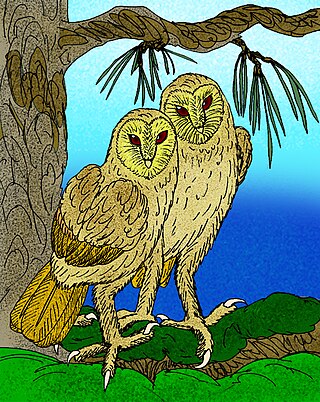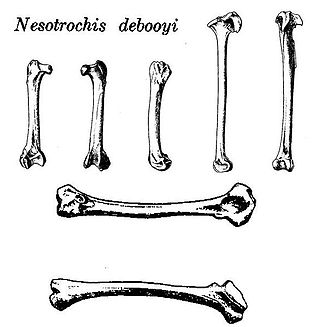
Flightless birds are birds that, through evolution, lost the ability to fly. There are over 60 extant species, including the well-known ratites and penguins. The smallest flightless bird is the Inaccessible Island rail. The largest flightless bird, which is also the largest living bird in general, is the ostrich.

Sylviornis is an extinct genus of large, flightless bird that was endemic to the islands of New Caledonia in the Western Pacific. It is considered to constitute one of two genera in the extinct family Sylviornithidae, alongside Megavitiornis from Fiji, which are related to the Galliformes, the group containing the turkeys, chickens, quails and pheasants. Sylviornis was never encountered alive by scientists, but it is known from many thousands of subfossil bones found in deposits, some of them from the Holocene, on New Caledonia and the adjacent Île des Pins. It was likely hunted to extinction shortly after the first human arrival to New Caledonia around 1500 BC.

Tyto pollens is an extinct giant barn owl which lived in the Bahamas during the last Ice Age.

Cygnus falconeri, the giant swan, is an extinct, very large swan known from Middle Pleistocene-aged deposits from Malta and Sicily. Its dimensions are described as exceeding those of the living mute swan by one-third, which would give a bill-to-tail length of about 190–210 cm (75–83 in). By comparison to the bones of living swans, it can be estimated that it weighed around 16 kg (35 lb) and had a wingspan of about 3 m (9.8 ft). It would have been taller, though not heavier, than the region's dwarf elephants. Due to its size, it may have been flightless. It became extinct before the increase in human activity in the region, so its disappearance is thought to have resulted from extreme climate fluctuations or the arrival of predators and superior competitors. Its bones are exhibited at Għar Dalam museum in Birżebbuġa, Malta.
Jackson's Bay Cave is a very large cave on the Portland Ridge in Clarendon near the south coast of Jamaica. It is considered to be one of the most beautiful in the Caribbean. It was discovered in 1964. It is part of the Jackson bay cave system, consisting of 14 unconnected caves, and over 9200m of cumulated caves passages mapped since then. The longest of them, Jackson Bay Great Cave is over 3.360 kilometres (2.088 mi) long.
Paleontology or palaeontology is the study of prehistoric life forms on Earth through the examination of plant and animal fossils. This includes the study of body fossils, tracks (ichnites), burrows, cast-off parts, fossilised feces (coprolites), palynomorphs and chemical residues. Because humans have encountered fossils for millennia, paleontology has a long history both before and after becoming formalized as a science. This article records significant discoveries and events related to paleontology that occurred or were published in the year 1989.

The Antillean cave rail, also known as DeBooy's rail, is an extinct species of flightless bird which occurred on Puerto Rico and the United States Virgin Islands.
Paleontology or palaeontology is the study of prehistoric life forms on Earth through the examination of plant and animal fossils. This includes the study of body fossils, tracks (ichnites), burrows, cast-off parts, fossilised feces (coprolites), palynomorphs and chemical residues. Because humans have encountered fossils for millennia, paleontology has a long history both before and after becoming formalized as a science. This article records significant discoveries and events related to paleontology that occurred or were published in the year 1977.
Paleontology or palaeontology is the study of prehistoric life forms on Earth through the examination of plant and animal fossils. This includes the study of body fossils, tracks (ichnites), burrows, cast-off parts, fossilised feces (coprolites), palynomorphs and chemical residues. Because humans have encountered fossils for millennia, paleontology has a long history both before and after becoming formalized as a science. This article records significant discoveries and events related to paleontology that occurred or were published in the year 1976.

The Martinique macaw or orange-bellied macaw is a hypothetical extinct species of macaw which may have been endemic to the Lesser Antillean island of Martinique, in the eastern Caribbean Sea. It was scientifically named by Walter Rothschild in 1905, based on a 1630s description of "blue and orange-yellow" macaws by Jacques Bouton. No other evidence of its existence is known, but it may have been identified in contemporary artwork. Some writers have suggested that the birds observed were actually blue-and-yellow macaws. The "red-tailed blue-and-yellow macaw", another species named by Rothschild in 1907 based on a 1658 account, is thought to be identical to the Martinique macaw, if either one ever existed.
Titanohierax gloveralleni, also known as the Bahama eagle, is a large species of extinct hawk from the Late Quaternary of the Caribbean. Remains of the animal have been found on multiple islands in The Bahamas. The animal is known from a handful of bones found across multiple islands, including a tarsometatarsus, partial metacarpal, and nearly complete right ulna. The animal was described based off the former two by Alexander Wetmore in 1937, with all other currently referred material being assigned by Storrs Olson and colleagues in 1982.
The Jamaican caracara is a prehistoric species of terrestrial bird in the falcon family, Falconidae. It was native to the island of Jamaica in the Caribbean, where it probably inhabited dry forests in the island's south during the early Holocene. This species was described based on fossils discovered in the Skeleton Cave in the Jackson's Bay Cave system on the south coast of Portland Ridge.

The Jamaican ibis, Jamaican flightless ibis or clubbed-wing ibis is an extinct bird species of the ibis subfamily uniquely characterized by its club-like wings. It is the only species in the genus Xenicibis, and one of only two flightless ibis genera, the other being the genus Apteribis which was endemic to Hawaii's islands of Maui Nui.

Apteribis is an extinct genus of flightless birds in the ibis subfamily that was endemic to the Hawaiian Islands in the Pacific Ocean.
Swansea Cave is a cave and palaeontological site in the Saint Catherine Parish of south-eastern Jamaica.
Red Hills Fissure is a palaeontological site at the Red Hills in Saint Andrew Parish of south-eastern Jamaica.
The Pindai Caves of New Caledonia are an archaeological and palaeontological site important for the study of prehistoric human settlement as well as of the Holocene fauna of the island. The Pindai area has been occupied by humans for varying periods over the last 2,800 years.

The small-billed moa-nalo, also known as the stumbling moa-nalo, is a species of moa-nalo, one of a group of extinct, flightless, large goose-like ducks, which evolved in the Hawaiian Islands of the North Pacific Ocean. It was described in 1991 from subfossil material collected in September 1982 by Storrs Olson, Helen James and others, from the Auwahi Cave on the southern slopes of Haleakalā, on the island of Maui.









